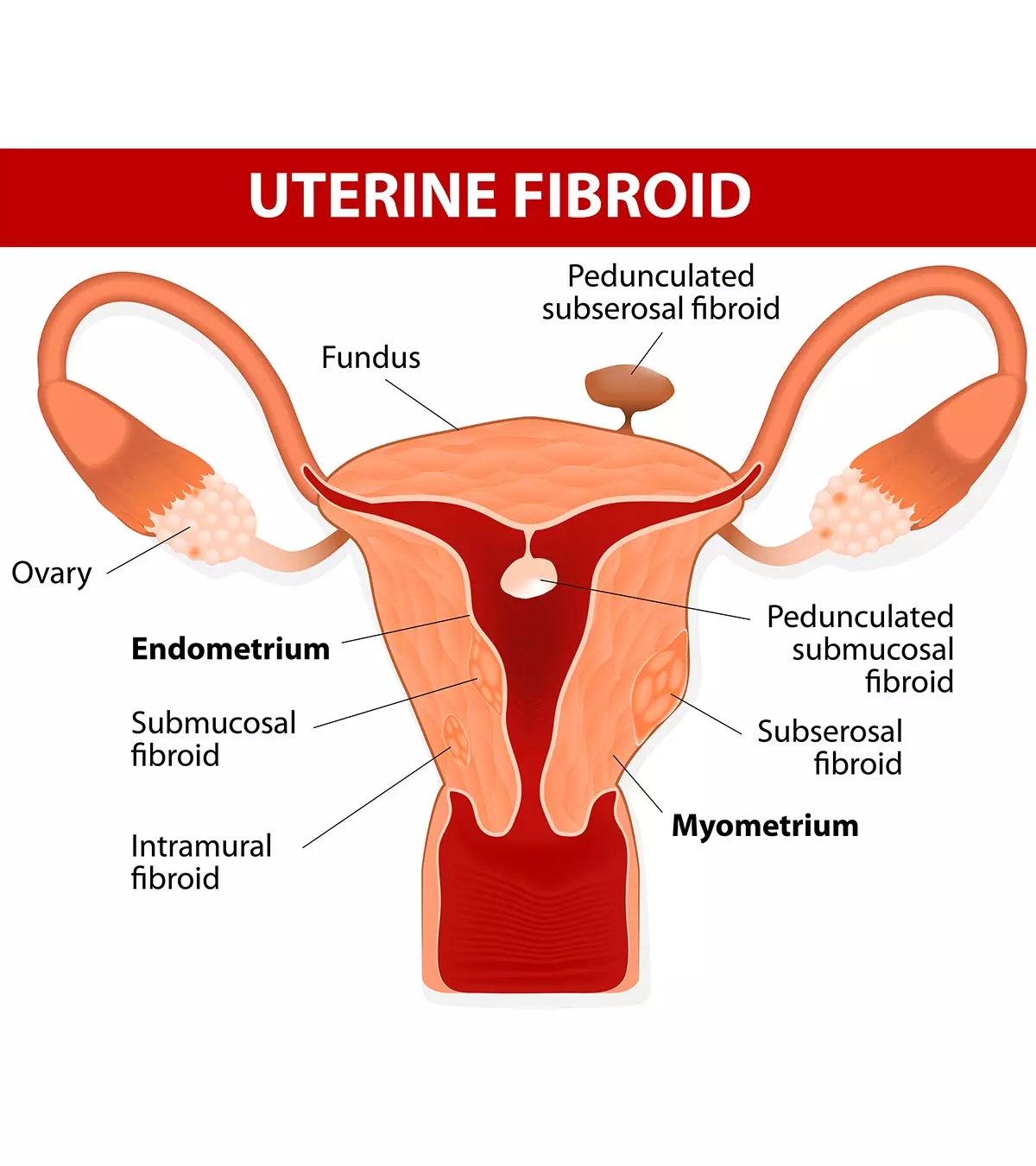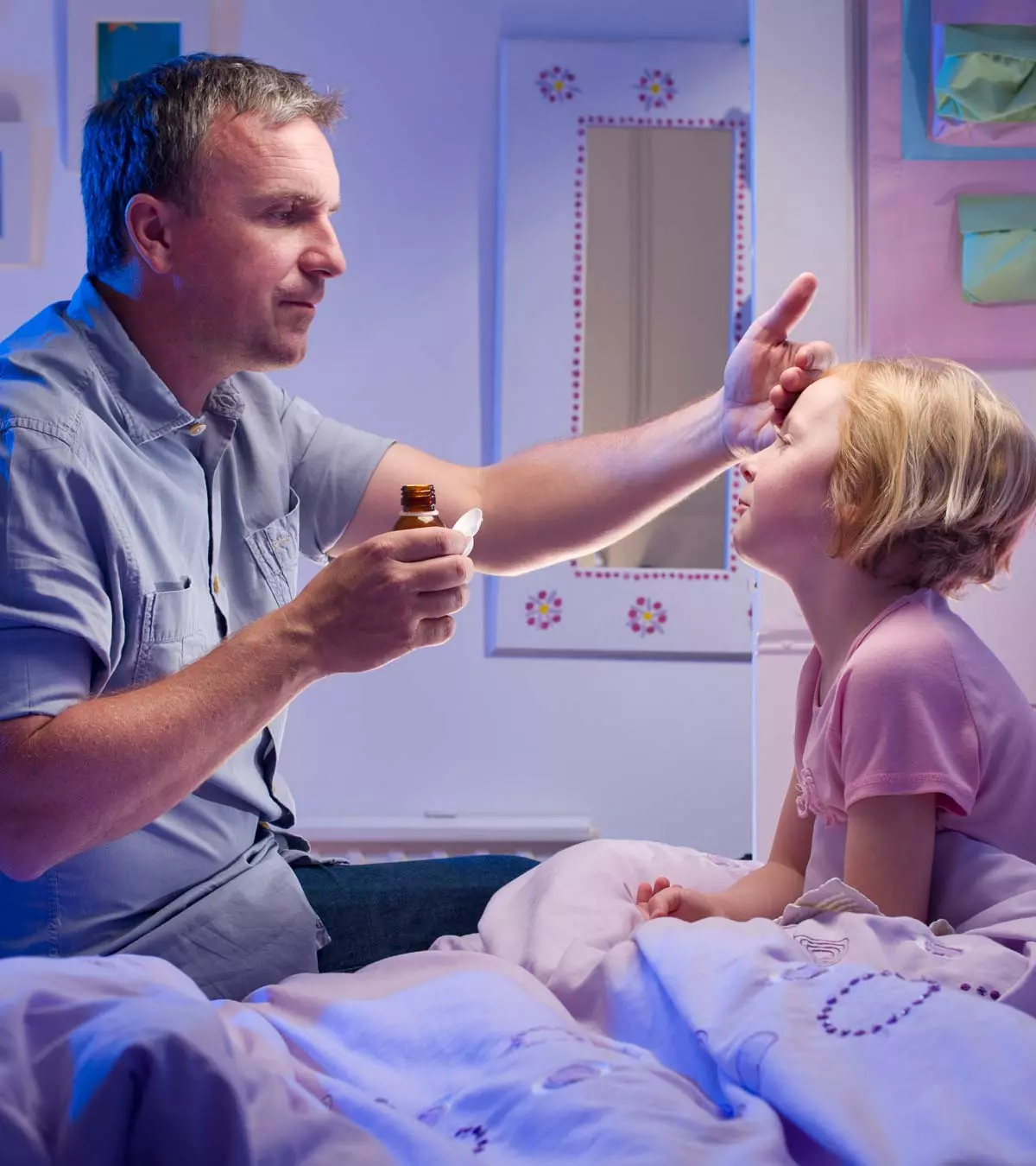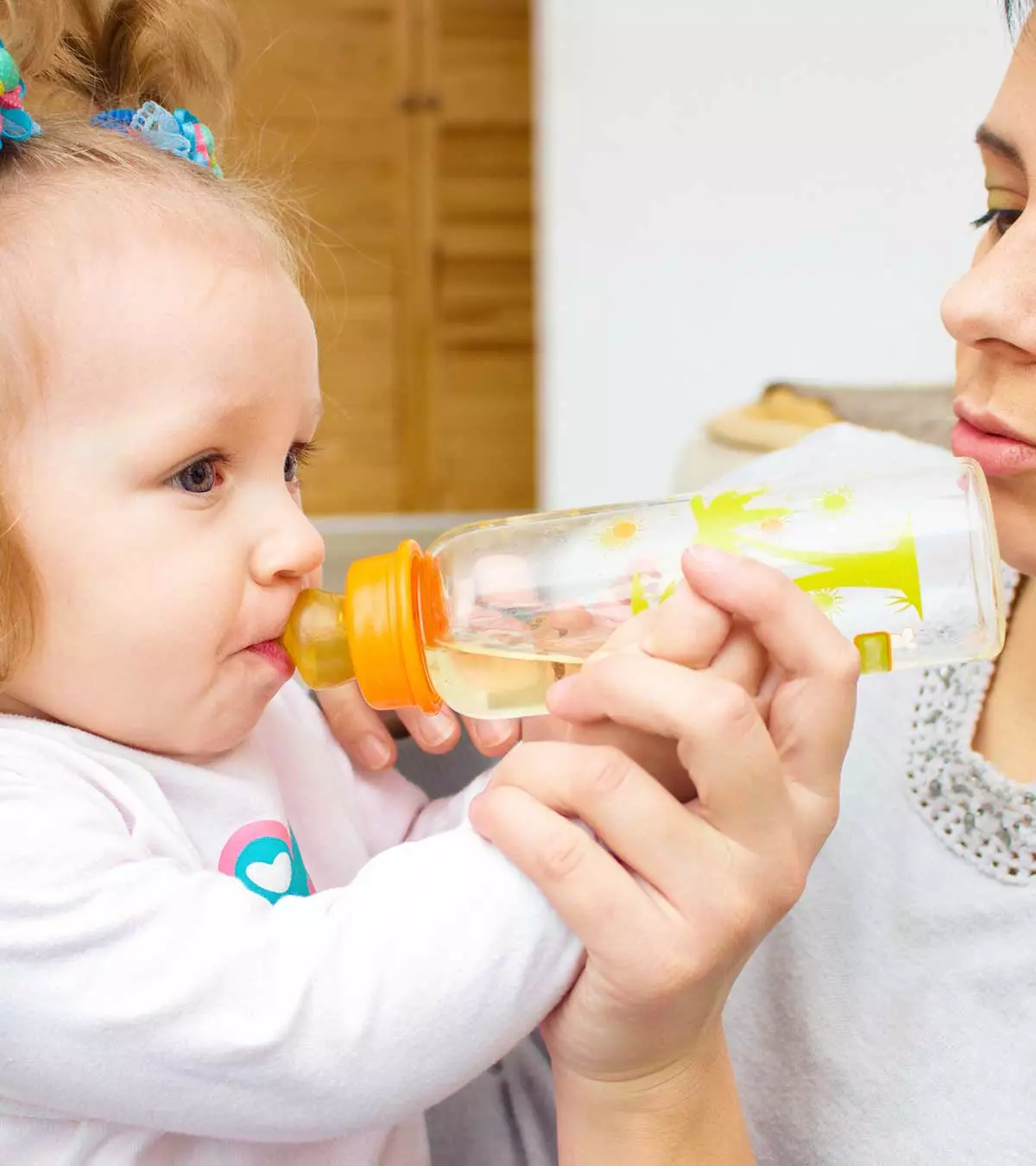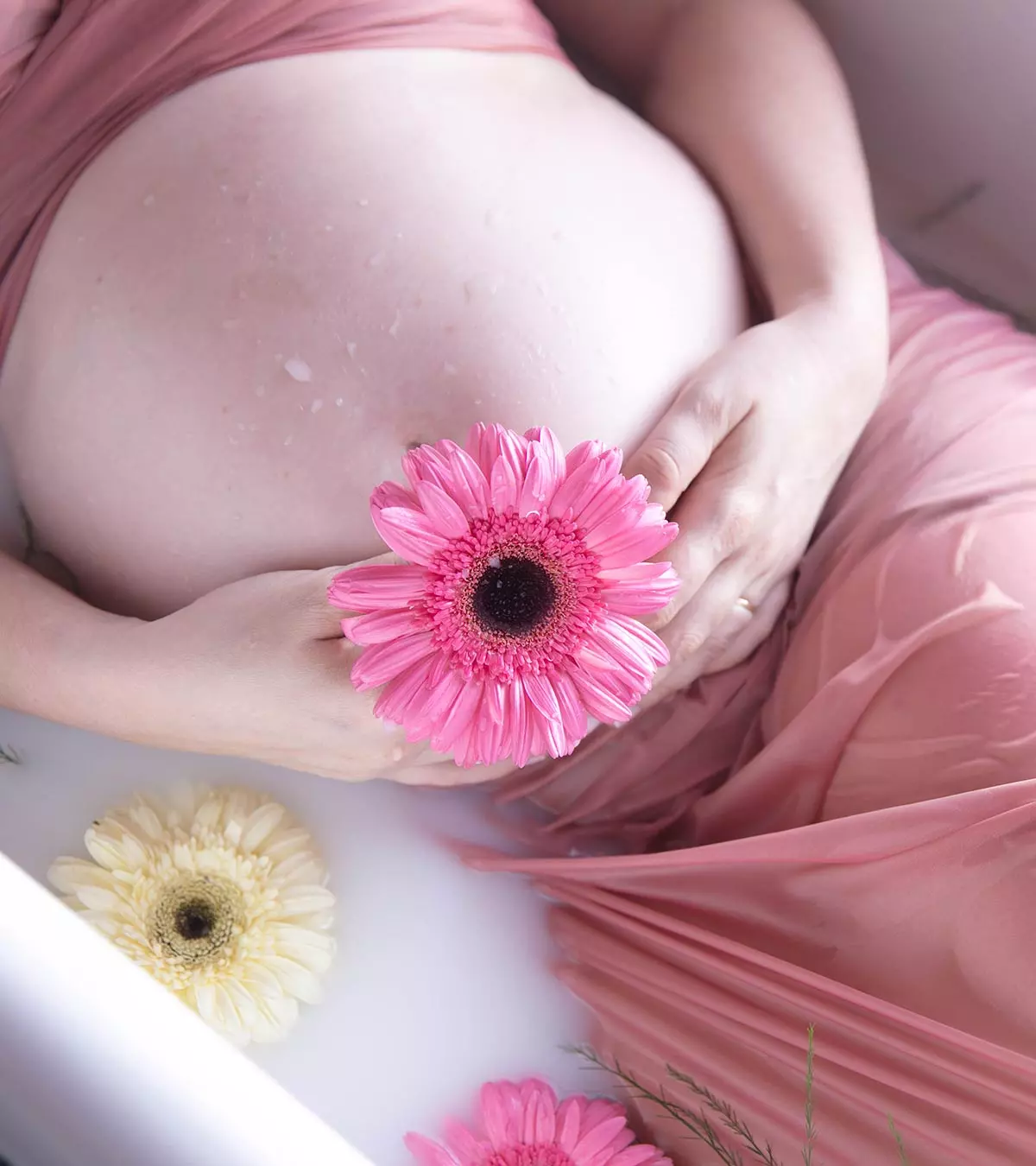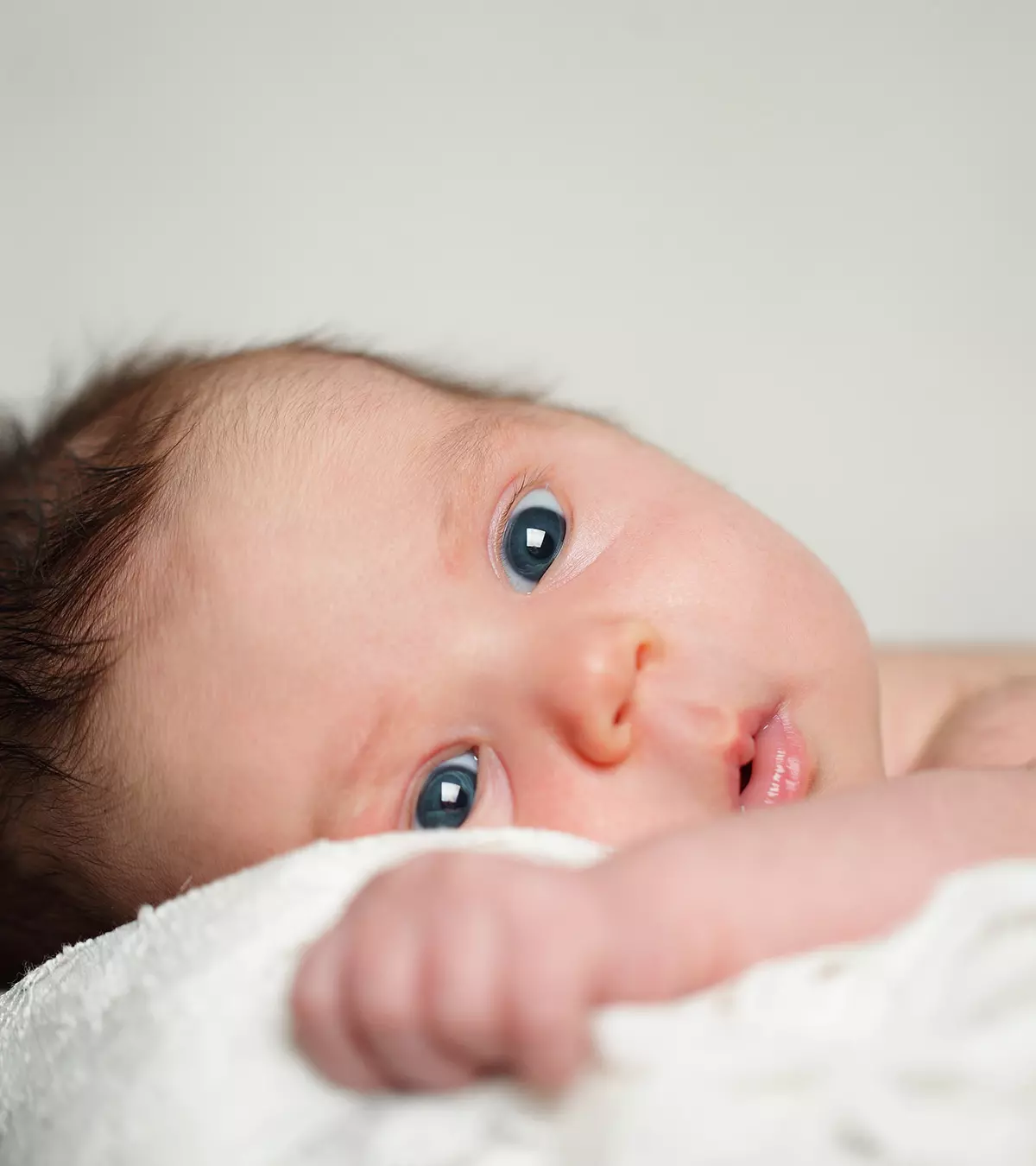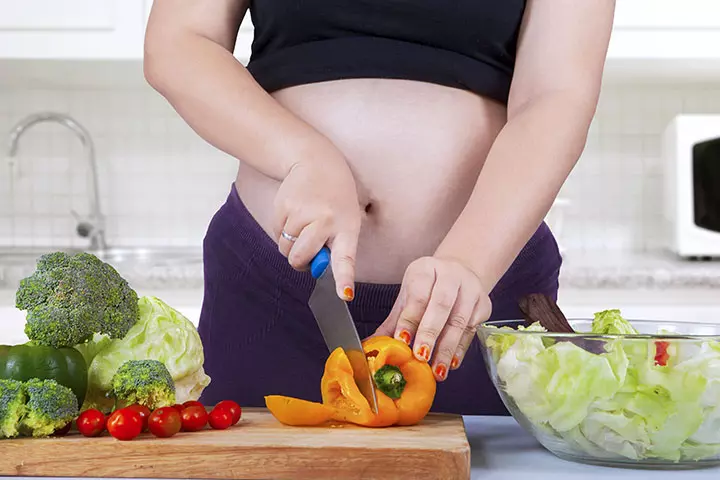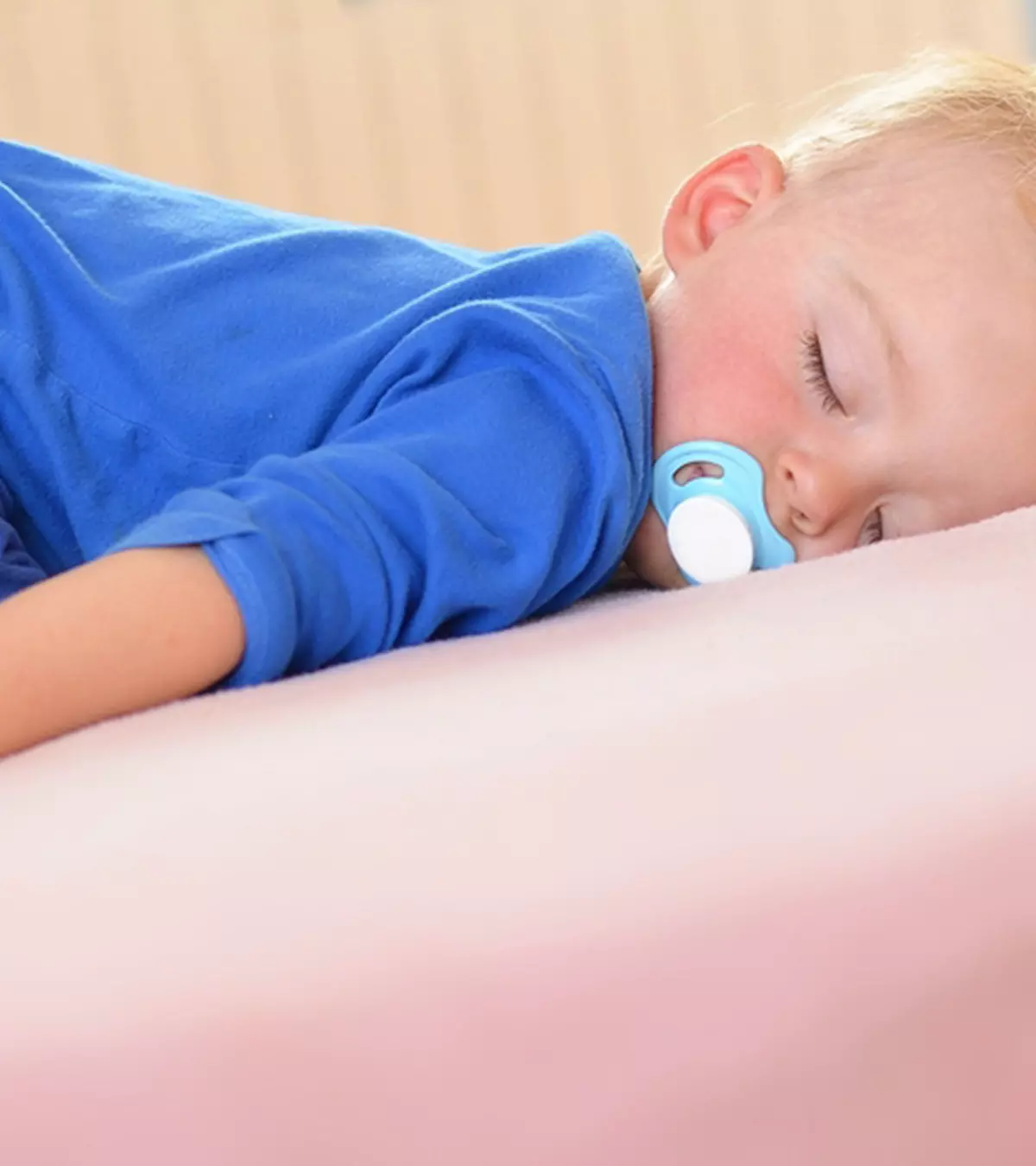
Shutterstock
An inclined sleeper for babies is a compact bassinet with an inclined sleep surface that keeps the baby’s body in an inclined position while sleeping or lying. The sleeper’s base usually has an inclination range of 10 to 30 degrees (1).

Once a popular baby product, inclined baby sleepers for babies are now known to have apparent design flaws. Baby nests, pods, rocks, docks, rockers, loungers, and nappers are other names by which inclined sleepers are known in the market.
Keep reading to know more about the risks of using inclined sleepers for babies and the safe sleep guidelines to follow.
Key Pointers
- Baby necks are not stable, and an inclined sleeper is unsafe as it increases the risk of accidental suffocation.
- Babies can roll over more easily on an inclined surface and be seriously injured.
- They should always sleep on a flat, firm surface, such as a crib or bassinet, with a fitted mattress.
Is It Okay For Babies To Sleep At An Incline?
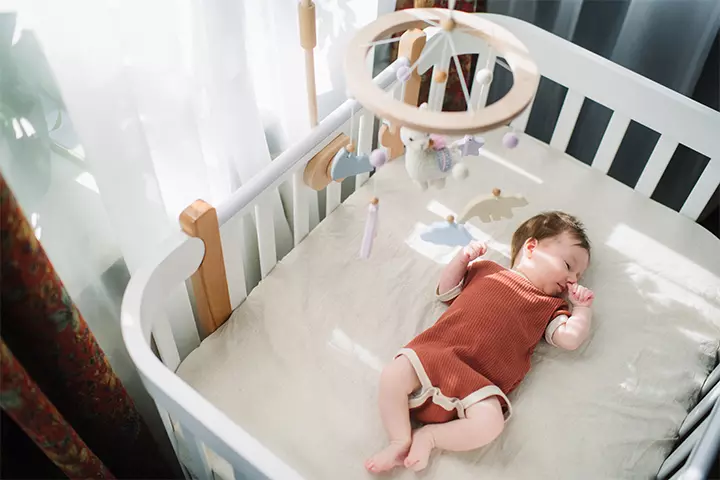
Sleeping at an incline is not advised and is considered one of the most unsafe sleeping positions for babies. It can be unsafe for the baby. Parents may believe that placing their baby in an inclined position can prevent certain health conditions, such as reflux, but it is incorrect. In fact, the semi-inclined position might even exacerbate a baby’s acid reflux.
According to the American Academy of Pediatrics, babies should always sleep flat on their backs, unrestrained. The sleeping mattress should be firm with fitted sheets without any soft items such as pillows, blankets, bumpers, or quilts. A healthy baby with acid reflux can also safely sleep on their back. They will reflexively swallow or cough up any spit up or vomit, preventing suffocation (2) (3).
What Makes Inclined Sleepers Dangerous?
Inclined sleepers are dangerous due to their inclined sleep surface, which could dangerously affect the baby’s position. It may lead to the following potentially fatal scenarios and incidents for the baby (4).
- Babies can suffocate or get smothered by sleeping in inclined sleepers. A baby’s head may fall on their chest in the inclined position due to their poor head control. This may block the airways and affect their breathing.
- The soft and plush surface may seem comfortable but is potentially dangerous for babies. If they roll and their face presses against the cushion, pushing the head back up might be difficult for them. As a result, they might suffocate against the padded surface.
- Babies who wiggle or move around a lot might try to change their position. If left unattended, there is a considerable risk of them getting injured by rolling off the inclined sleeper and getting pinned under them. The fall itself may cause serious injury.

- According to a study by US-CPSC (United States Consumer Product Safety Commission), compared to flat surfaces, babies can roll over more easily on an inclined surface. A baby could tire out faster when lying on their stomachs, causing exhaustion, which might make it difficult to get back to the correct position. It could ultimately lead to suffocation.
- The study also concluded that no baby gear and inclined sleep products, including swings and recliners, are safe for babies, irrespective of the manufacturer’s claims. According to a CPSC report, from January 2005 through June 2019, a total of 1,108 incidents, including 73 infant mortalities, were reported in connection with infant-inclined sleep products. A flat surface with an incline of no more than 10 degrees is the safest place for a baby to sleep for naps and nighttime sleep.
Why Are Inclined Sleepers Available If They Are Dangerous?
Despite their availability, several government authorities and pediatric organizations are working on recalling and restricting the sale of inclined sleepers. In June 2025, the CPSC sanctioned federal safety standards, which prevents the sale of dangerous baby products, including inclined sleepers. The standards will go into effect from mid-2025 and include restrictions on other potentially dangerous baby sleep products, such as loungers, in-bed sleepers, and travel or compact infant sleepers (1).
A bill was initiated in 2019 to ban the manufacture and sale of infant sleepers officially. However, it is not implemented yet. It has been passed by the House of Representatives and is currently in the US Senate (5).
 Safety tip
Safety tipManufacturers and retailers have played their part in recalling inclined sleepers due to the growing awareness of its potential to cause fatality. Since April 2019, more than five million inclined sleepers have been recalled. Several retailers, including online sellers, have promised to stop selling inclined sleepers eventually.
What To Do If You Own An Inclined Sleeper?
If you own an inclined sleeper, do not use it. Some manufacturers are taking the product back, and you may reach out to them to check eligibility for product return. They might refund your money or provide a voucher. It is also recommended to report the product to the Consumer Product Safety Commission (CPSC) and check for any recall notices. Engaging with the CPSC helps raise awareness about unsafe products and nurtures consumer safety..
You must discard the product if you cannot return it since it is not advised to sell or donate an inclined sleeper. It is best to destroy the product to prevent it from accidentally reaching the hands of someone who may consider using it for their baby (5).
Guidelines For Your Baby’s Safe Sleep
Here are some safe sleep guidelines to protect your baby from sudden infant death syndrome (SIDS) and other sleep-related accidents (6) (7).
- Babies should always be placed on their backs for sleep, including daytime naps. This is critical in the first 12 months to lower the risk of SIDS.
- Babies should always sleep on a flat, firm surface with a fitted mattress. There should be no soft objects in the vicinity. Do not put them to sleep on furniture with soft surfaces such as the couch, armchair, pillow, blanket, waterbed, quilt, or blanket.
- Protect the baby from suffocation by ensuring their sleep area is free of toys, crib bumpers, soft objects, and loose bedding.

- Place the baby in the designated sleep area, such as the crib, after breastfeeding is done. Avoid dozing off while the baby is still latched to the breasts.
- Sleep in the same room as the baby but keep their sleeping area separate for the first 12 months. You can place the baby’s crib close to your bed to make it easier to breastfeed or comfort the baby. Avoid co-sleeping with baby, that is, do not put the baby to sleep on your bed.
Sharing the experience and benefits of room-sharing with her newborn, Andrea Kruse, a mother of three, recounts, “After trying many products and techniques with my first baby, we turned to a side sleeper for my daughter that attaches to my side of the bed. This is what I recommend to friends having their first child. It allows me to sleep right next to a newborn, nurse easily and we can all get some sleep (i).”
 Quick fact
Quick fact
- A pacifier may lower the risk of SIDS. A baby pacifier may be introduced once breastfeeding is established, which may take about four weeks after the baby’s birth. In the case of bottle-fed babies, you may offer a pacifier at your convenience. There is no need to reinsert a pacifier if it falls out of a sleeping baby’s mouth. Do not tie the pacifier with a string around the baby’s neck or crib since the string may increase the risk of accidental strangulation.
- Ensure that the baby does not overheat while sleeping. Dress your baby in weather-appropriate clothing. The layers should not exceed more than one additional layer compared to adults. Stay alert to signs of overheating, such as increased body temperature or excess sweating.
- Do not use products or gadgets that do not fulfill the safe sleep recommendations. Products that assure prevention or decreased chance of SIDS should be avoided. Positioners or other products that claim to keep the baby in a particular position have often not been proven safe by research.
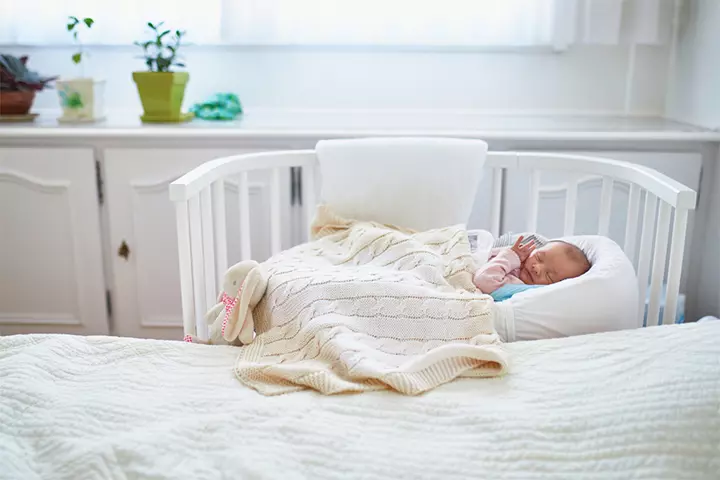
- Avoid smoking, alcohol, and narcotics, which could diminish your alertness and focus on your baby’s safety. Prevent others from smoking around the baby since secondhand smoke may increase the risk of SIDS.
Frequently Asked Questions
1. Do babies sleep better flat or inclined?
According to the American Academy of Pediatrics (AAP), babies should not be left sleeping in an inclined position. While putting them down to sleep, always place your baby on their back on a separate, flat, and firm surface free of blankets, bedding, and toys (3).
2. How can I elevate my baby’s head while sleeping?
Elevating your baby’s head while asleep is not recommended because it can put your baby at risk of rolling to the foot of the bed or getting into a position that can cause severe breathing problems. Hence, avoid devices designed to elevate the baby’s head (3).
3. Why should babies sleep flat?
Babies can breathe more easily when placed in a flat sleeping position on their back. This sleeping position also reduces the chances of SIDS, choking, and other sleep-related complications (8).
You may be wondering if inclined sleepers for babies are useful for resolving issues such as reflux in newborns. However, research has proven that these inclined sleepers may do more harm than good. They may cause several issues such as suffocation, injury, and SIDS. These risks have caused the government to recall these products and revoke further sales of inclined sleepers for babies. Based on all the reviews and research, it may be best to avoid using inclined sleepers for babies and stick to cribs for their nap times and bedtimes.
Infographic: What Makes Inclined Sleepers Dangerous?
Although most inclined baby sleepers, such as loungers and rockers, come with a soft cushion and may seem reasonable to comfort your baby, most government organizations advise against using them. This infographic explains why an inclined sleeper may not be safe for babies.
Some thing wrong with infographic shortcode. please verify shortcode syntax
Illustration: Inclined Sleeper For Baby: Why Are They So Dangerous?
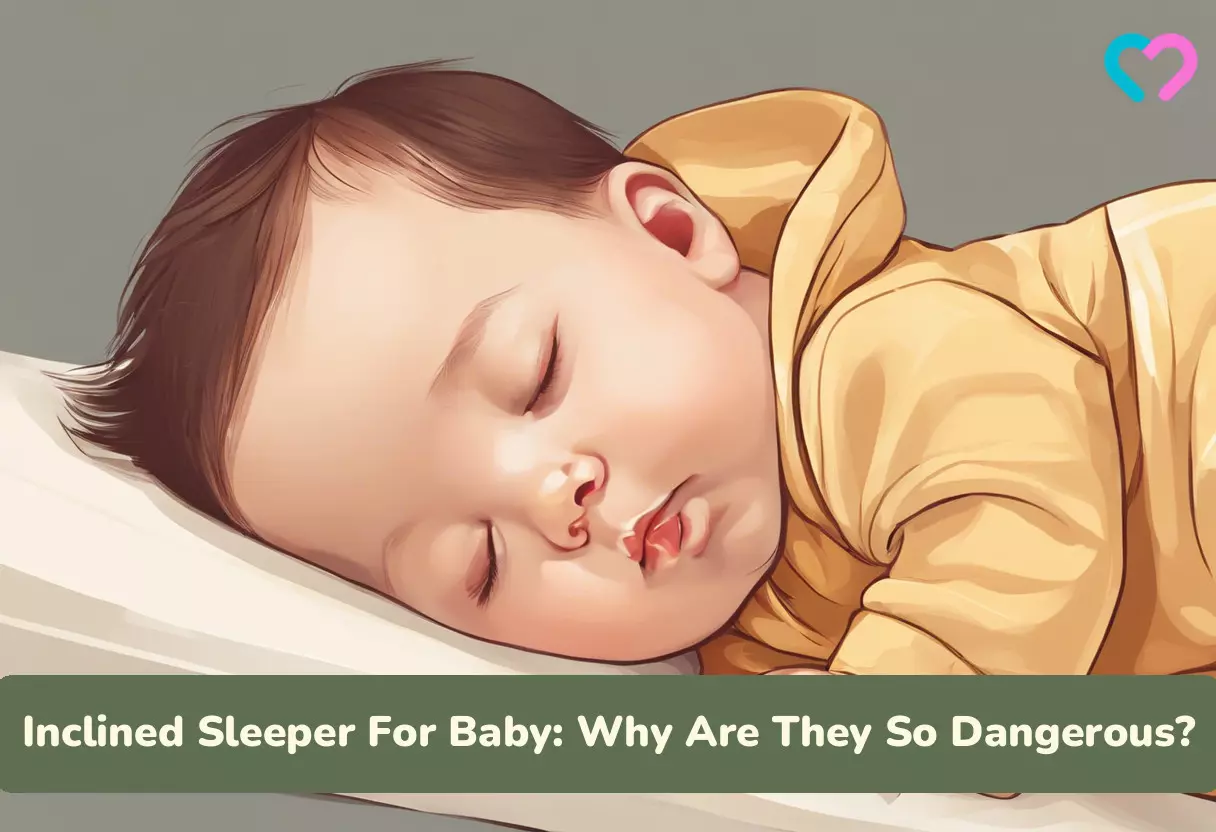
Image: Stable Diffusion/MomJunction Design Team
Personal Experience: Source
MomJunction articles include first-hand experiences to provide you with better insights through real-life narratives. Here are the sources of personal accounts referenced in this article.
i. The guide to baby sleep positions – A hilarious take on co-sleeping antics (Review);https://adventuresinallthingsfood.blogspot.com/2013/05/the-guide-to-baby-sleep-positions.html?m=0
References
- Inclined Sleepers and Other Baby Registry Items to Avoid; American Academy of Pediatrics
https://www.healthychildren.org/English/ages-stages/baby/sleep/Pages/Inclined-Sleepers-and-Other-Baby-Registry-Items-to-Avoid.aspx - Infant Sleep Position and SIDS; US Department of Health and Human Services
https://www.nichd.nih.gov/sites/default/files/publications/pubs/documents/SIDS_QA-508-rev.pdf - What is the safest sleep solution for my baby with reflux?; American Academy of Pediatrics
https://www.healthychildren.org/English/tips-tools/ask-the-pediatrician/Pages/What-is-the-safest-sleep-solution-for-my-baby-with-reflux.aspx - All Infant Inclined Sleep Products Should Be Recalled Consumer Reports Says Consumer Reports
https://www.consumerreports.org/babies-kids/child-safety/all-infant-inclined-sleep-products-should-be-recalled-consumer-reports-says-a6892362022/ - Guide to Recalled Infant Inclined Sleepers Nappers and Loungers; Consumer Reports
https://www.consumerreports.org/babies-kids/child-safety/recalled-infant-inclined-sleepers-nappers-loungers-guide-a3141771657/ - Safe Sleep: Recommendations; American Academy of Pediatrics
https://www.aap.org/en/patient-care/safe-sleep/ - Ways to Reduce Baby’s Risk; US Department of Health and Human Services
https://safetosleep.nichd.nih.gov/reduce-risk/reduce - Research on Back Sleeping And SIDS
https://safetosleep.nichd.nih.gov/ - Safe Sleep for Babies Act Business Guidance.
https://www.cpsc.gov/Business–Manufacturing/Business-Education/Business-Guidance/Safe-Sleep-for-Babies-Act-Business-Guidance - Soft bedding poses grave danger to sleeping babies study shows.
https://news.virginia.edu/content/soft-bedding-poses-grave-danger-sleeping-babies-study-shows
Community Experiences
Join the conversation and become a part of our nurturing community! Share your stories, experiences, and insights to connect with fellow parents.
Read full bio of Dr. Dur Afshar Agha
Read full bio of Shivali Karande
Read full bio of Rohit Garoo
Read full bio of Vidya Tadapatri






